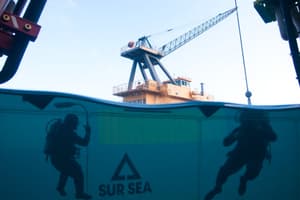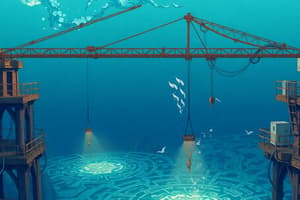Podcast
Questions and Answers
During the subsea spool tie-in operation described, what primary factor led the Diving Supervisor to incorrectly assume the crane hook had reached the seabed?
During the subsea spool tie-in operation described, what primary factor led the Diving Supervisor to incorrectly assume the crane hook had reached the seabed?
- Confirmation from the pre-operation inspection checklist.
- Visual confirmation from underwater cameras.
- The crane operator's report of 'no weight' on the crane wire. (correct)
- The diver's report of 'no weight' on the crane wire.
Which of the following actions would be MOST effective in preventing a recurrence of the incident described?
Which of the following actions would be MOST effective in preventing a recurrence of the incident described?
- Requiring divers to wear additional protective gear.
- Using underwater cameras and sonar to monitor critical equipment position. (correct)
- Implementing a buddy system for divers to visually monitor crane hook position.
- Increasing the frequency of pre-operation inspections of diving helmets.
In the context of subsea operations, why is it critical to establish clear communication and confirmation procedures regarding equipment location?
In the context of subsea operations, why is it critical to establish clear communication and confirmation procedures regarding equipment location?
- To minimize the amount of time spent on pre-operation briefings.
- To allow the diving supervisor to focus on other tasks.
- To ensure all parties are aware of potential hazards and can respond accordingly. (correct)
- To reduce the need for underwater visibility aids.
What was the significance of the diver being unharmed despite the helmet damage?
What was the significance of the diver being unharmed despite the helmet damage?
What immediate action did the divers take following the incident, and why was this important?
What immediate action did the divers take following the incident, and why was this important?
Flashcards
Subsea Incident Cause
Subsea Incident Cause
During subsea operations, a crane hook struck a diver's helmet due to the operator assuming the hook had reached the seabed, when it had not, worsened by poor visibility.
Preventative Actions
Preventative Actions
Ensure adequate distance between divers and crane hooks, use visibility aids, improve monitoring, and reinforce clear communication and challenge assumptions.
Visibility Aids
Visibility Aids
In poor visibility, use additional locating beacons, underwater cameras, or sonar to accurately track the position of critical equipment like the crane hook.
Communication Importance
Communication Importance
Signup and view all the flashcards
Procedural Updates
Procedural Updates
Signup and view all the flashcards
Study Notes
- During subsea spool tie-in operations, a crane hook unexpectedly struck a diver’s helmet.
What Happened?
- Divers were working on the seabed in poor visibility during subsea spool tie-in operations.
- After landing the pipe handling frame (PHF) on the seabed, the Diving Supervisor told the crane operator to lower the crane hook to the seabed for rigging disconnection.
- The crane operator reported ‘no weight’ on the crane wire, so the Diving Supervisor assumed the hook had reached the seabed and instructed the diver to proceed with disconnecting the PHF.
- The crane hook unexpectedly struck the diver’s helmet while the diver was under the PHF to disconnect the rigging.
- The diver was unharmed and returned to the dive bell; the dive was aborted.
- The diver’s reclaim helmet was damaged beyond repair, including the side block of the helmet.
- The integrity of the helmet was maintained throughout the impact, showing the high quality and durability of the diving helmets.
- The diver was unharmed in the incident.
What Went Right?
- Diver 2 assisted Diver 1, ensuring no injuries were sustained, and both divers returned to the bell safely.
- Both divers and the crane block had locating beacons, enabling accurate tracking.
- Lifting plans, Job Hazard Analysis (JHA’s), and procedures were followed throughout the operation.
- The diver was uninjured because the helmet absorbed the impact.
What Went Wrong?
- When lowered for PHF rigging disconnection, the crane hook rested on the top beam of the PHF.
- The hook resting on the top beam resulted in a ‘no weight’ reading, leading the crane operator to assume the hook had reached the seabed.
- As the diver approached the disconnection point, the hook slipped off the beam and struck the side of the diver’s helmet.
What Was The Cause?
- The crane pennant/stinger was an inadequate length, which did not provide enough distance between the divers and the crane hook.
- Poor visibility hindered the ability to accurately observe the position of the crane hook.
Lessons and Actions
- Ensure adequate distance between divers and the crane hook by using a crane pennant/stinger of sufficient length to maintain a safe distance during subsea operations to reduce accidental contact, especially in limited visibility.
- Enhance visibility aids and monitoring: use alternate methods in low visibility environments, such as additional locating beacons, underwater cameras, or sonar, to better track critical equipment like the crane hook, to prevent misjudgments.
- Reinforce communications and challenge assumptions by minimizing assumptions regarding equipment position.
- Reinforce clear communication and confirmation procedures between the dive supervisor, crane operator, and divers to ensure all parties know the equipment’s location at all times.
- Project procedures were updated to specify minimum pennant lengths for different operations.
- Pre-operation inspections of all rigging and lifting equipment were conducted, including crane hooks and pennants, to ensure they meet safety standards.
- The Job Hazard Analysis (JHA) was updated to incorporate lessons learned regarding safe distances, visibility, and communication requirements for subsea lifting operations.
Studying That Suits You
Use AI to generate personalized quizzes and flashcards to suit your learning preferences.




